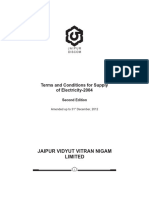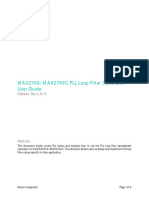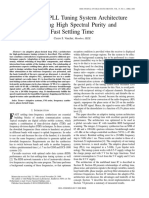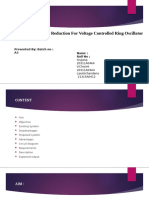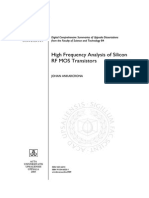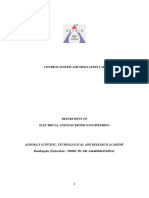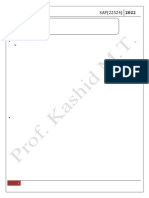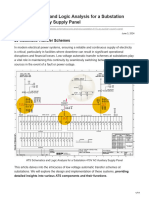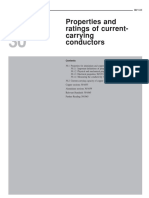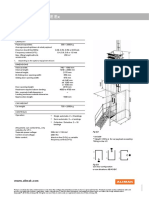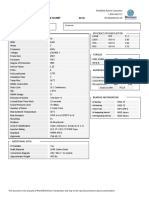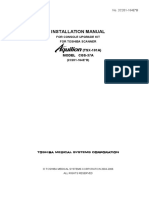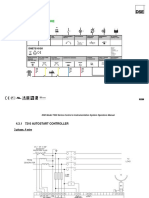Fractional Spurs Dynamical Suppression
Fractional Spurs Dynamical Suppression
Uploaded by
A. VillaCopyright:
Available Formats
Fractional Spurs Dynamical Suppression
Fractional Spurs Dynamical Suppression
Uploaded by
A. VillaOriginal Description:
Copyright
Available Formats
Share this document
Did you find this document useful?
Is this content inappropriate?
Copyright:
Available Formats
Fractional Spurs Dynamical Suppression
Fractional Spurs Dynamical Suppression
Uploaded by
A. VillaCopyright:
Available Formats
Fractional-N Synthesizers: Dynamic Scheme of Fractional Spurs Suppression
Author(s): Motorola
Muhammad Douban Abdul Rahman Yu Kok Hoong Anwar Faizd Osman
IP.com number: Original Publication Date: IP.com Electronic Publication: Copyright:
IPCOM000160375D November 16, 2007 November 16, 2007 2007 Motorola, Inc.
IP.com, Inc. is the worlds leader in defensive publications. The largest and most innovative companies publish their technical disclosures into the IP.com Prior Art Database. Disclosures can be published in any language, and they are searchable in those languages online. Unique identifiers indicate documents containing chemical structures as well as publications open for comment in the IP Discussion Forum. Disclosures are published every day online and also appear in the printed IP.com Journal. The IP.com Prior Art Database is freely available to search by patent examiners throughout the world. Client may copy any content obtained through the site for Client's individual, noncommercial internal use only. Client agrees not to otherwise copy, change, upload, transmit, sell, publish, commercially exploit, modify, create derivative works or distribute any content available through the site. Note: This is a pdf rendering of the actual disclosure. To access the notarized disclosure package containing an exact copy of the publication in its original format as well as any attached files, please download the full document from the IP.com Prior Art Database at: http://www.ip.com/pubview/IPCOM000160375D
www.ip.com
Copyright IP.com, Inc. All rights reserved.
Fractional-N Synthesizers: Dynamic Scheme of Fractional Spurs Suppression
Authors: Muhammad Douban Abdul Rahman, Yu Kok Hoong, Anwar Faizd Osman
Abstract Fractional-N synthesizers have been used for many years to improve the performance of indirect frequency synthesizers. The Fractional-N synthesizer has been acknowledged with the ability to decrease phase noise, provide increased loop speed for a given small step size, and provide reduced reference spurs level. However, one major stigma attached to Fractional-N synthesizer is their poor spurious performance. The most phenomenal spurs found on the Fractional-N synthesizers are fractional spurs. They appear all around the Voltage Controlled Oscillator (VCO) carrier regardless of the frequency to which it is programmed. The spacing of these spurs is usually equal to the channel step size of the Fractional-N synthesizer. The exact mechanism that precipitates these spurs is not entirely understood. The spurs tend to lessen when the VCO drive level into the divider port is lowered. This paper will discuss on some of the fundamentals of the Fractional-N synthesizers and the dynamic scheme of the fractional spurs suppression at which it uses the technique of varying the reference divider, and charge pump currents to attenuate the spurs. This paper explores the fundamentals and the theory of Fractional-N synthesizers, how to hunt for the fractional spurs, and finally discusses on how different reference dividers and charge pump current settings help on the fractional spurs suppression improvement, which is the main agenda of this paper. Keywords- Fractional N spur suppression, synthesizers, VCO, dynamic scheme. I. INTRODUCTION
are compared in a phase and frequency detector (PFD). Any phase difference will be converted into a voltage by the means of a charge pump. A succeeding loop filter extracts the DC component of this voltage, which is then used to control the output signal frequency of a Voltage Controlled Oscillator (VCO). A PLL provides high output frequency accuracy at reasonable short settling time.
Figure 1: Basic Frequency PLL Block Diagram Several different frequency synthesizers architectures have been designed, implemented, and populated in the market today. One of the examples is the integer-N type, where a programmable divider in the feedback path divides the oscillator frequency by an integer value. These loops are characterized by a straightforward circuit implementation, but they suffer from large channel spacing and slower settling time due to loop bandwidth limitations. Fractional-N phase locked loops (PLLs) promise a theoretical performance edge over integer-N, but historically they have struggled to achieve this breakthrough [1]. Now, a new design has resulted in a Fractional-N PLL that lives up to its theoretical performance. Fractional-N loops overcome much of the integer-N types problems, as the output channel spacing can be a small (not only integer) fraction of the reference frequency. In practice, the division ratio is an average, placed between two integers, says N and N+1. As the reference frequency can now be higher, the loop bandwidth increases which reduces the settling time. However, the fractional-N PLLs exhibit spectral output spurs (fractional spurs). Their distance from the target frequency depends on the changing rate between N and N+1. This paper discusses a
Frequency synthesizers are an essential part of any modern transceiver system. They generate clocks and oscillator signals required for up and down conversion. The communication standards today, demand both high frequency accuracy and fast frequency settling time. One of the most frequently used synthesizer types is the phase-locked loop (PLL). Phases of two signals, for instances, from an external reference and a feedback signal from an oscillator,
2007 Motorola, Inc.
Therefore, a brief description on calculating the fractional divider of dynamic scheme of the fractional spurs suppression by randomizing or varying the reference division ratio, and also the charge pump current settings. The idea on this paper is different from other known solutions in terms of fractional spurs suppression at which, typically the Sigma-Delta noise shaping technique is employed for fractional spurs suppression. Fractional-N synthesizer will serve as a building block on understanding the operation of synthesizer ICs. The Fractional-N synthesizers divider calculation for the synthesizer IC is given by equation (3).
N f FVCO = M + 3 + ref D R
At which, M = MAINND N = MAINNUM D = 224 fref = Fr MHz, Reference frequency R = Reference frequency divider ranges from 1 to 7 IV. HOW TO HUNT FOR FRACTIONAL SPURS?
(2)
Figure 2: Fractional-N PLL Block Diagram II. FRACTIONAL-N SYNTHESIZERS BASIC THEORY
It is important and equally crucial to understand and realize that NOT all the frequencies possess fractional spurs [3]. IC designers have streamlined certain guidelines which can be used as guidance on hunting for the fractional spurs frequencies. A frequency is deemed to possess fractional spurs when it falls under any of the two conditions outlined below:
In a PLL, the VCO output frequency, fVCO is determined by the reference frequency, fref and the division ratio N, such that
(1) In conventional frequency synthesizers, the division ratio N is an integer. In order to achieve a fine frequency resolution, small reference frequency and a narrow loop bandwidth are needed. However, narrow loop bandwidth will cause a poor locking time (longer settling time). Fractional-N frequency synthesizer as shown on Figure2 is capable of achieving finer frequency resolution than the reference frequency. Dualmodulus pre-scaling technique has been implemented in order to obtain the fractional divider in the frequency synthesizer. In a fractional divider, the division ratio is periodically altered from N to N+1 [4]. V. DYNAMIC SCHEME OF FRACTIONAL SPURS SUPPRESSION Typically, when the fractional spurs suppression issue is a topic of discussions, engineers tends to bind their thoughts and consideration more III. DIVIDER CALCULATIONS OF FRACTIONAL-N SYNTHESIZERS towards layout considerations and good layout practice [5]. Among the good layout practice includes avoid routing long prescaler runner, and sandwiching all the dirty runners (clock runners, digital runners, and etc) with the ground planes. Holding tight with the good layout practice and principles helps a lot (3) By utilizing the equation given above, Fc= 403.125MHz contains the fractional N-spurs while Fc=403.54MHz free from fractional spurs.
This section will mainly focus on calculating the divider for synthesizer IC, currently implemented on some new radio products. The key concept of divider calculations on this IC is similar to any Fractional-N synthesizer.
2007 Motorola, Inc.
of the fractional spurs suppression with the R value of 7. At 6.25 kHz channel on the spurs suppression. However, it is interesting to notice that even after employing a very good layout practice on the design, there are still a lot more stubborn and nasty spurs appearing on the circuit, which consume most of the engineering effort and time on suppressing these spurs. This paper on the other hand, discusses a dynamic scheme of spurs suppression, namely fractional spurs. This particular scheme utilizes method of varying the reference frequency divider to avoid or bypass the fractional spurs. It is known fact that there are 2 conditions govern the fractional spurs frequencies, at which N is the main contributing factor whereas D is a fixed value. spacing, the fractional spurs suppression is -69dB whereas at the 12.5 kHz channel spacing, the fractional spurs suppression is -70.74dB, which undoubtedly meets the specifications.
(Prescal.Freq.) (Prescal.Freq.) 224 N = INT INT f ref f ref R R
(4) Figure 3: Fractional Spurs Performance Using the R=2
Taking a closer look at (4), most of the parameter is unchangeable except for the R value, which ranges from 1 to 7 (for this synthesizer IC case). Changing the R values significantly transform given carrier frequency from falling into fractional spurs region to a fractional spurs free region. Consider the sample calculation 1, by using the R value of 2, the carrier frequency of 403.125MHz falls under the fractional spurs region. However, by iterative calculations, it is determined that the R value of 7 transformed this carrier frequency from fractional spurs region to a fractional spurs free region. Changing the value of R to 7 dynamically changes the ratio of N over D to 0.97. Following Figure3 and Figure4 illustrates these changes graphically. Based on the Figure3, while using the R value of 2, the fractional spurs suppression at 6.25 kHz channel spacing is -48.56dB and at 12.5 kHz channel spacing, it is -49.46dB. Comparing these values against the specifications, typically, for 6.25 kHz channel spacing, the fractional spurs suppression required is -60dB whereas for the 12.5 kHz channel spacing, fractional spurs suppression needed is -70dB. The performance of the fractional spurs suppression shown on Figure3 is a way off, roughly about 10dB to 20dB off from the specifications. Optimizations and rework would be a very tough effort and almost impossible to attain improvement up to 10dB. Significant improvement on the fractional spurs suppression can be attained by varying Rs value from 2 to 7. Figure4 illustrates the performance From these series of graphical examples, it can be said that the dynamic scheme of fractional spurs suppression technique offered on this paper is a viable and practical fractional spurs suppression methodology. One of the most common as well as important questions arose pertaining to the idea proposed on this paper is on how to keep track of Rs value whether it is suitable or not for a given carrier frequency? The answer for this question is that, the software coding on the radio controller that is capable to cater and keep track of best R value for a given frequency. Figure8 shows the proposed software programming sequences flowchart in order to obtain a suitable R value. Figure 4: Fractional Spurs Performance Using R=7
2007 Motorola, Inc.
Figure 5: Effect of R on Loop Filter Bandwidth The loop bandwidth becomes narrower with the increase of the R value. Narrower loop bandwidth is a phenomenal for the lock time performance. Lock time (settling time) increases as the loop bandwidth gets narrower. The impact of increase on the R value upon the loop bandwidth is illustrated on the simulation results of Figure5. However, the loop bandwidth can be still attained back to its typical value by increasing the charge pump currents [2]. The effect of increasing charge pump current settings while using the higher R value is shown on the simulation results of Figure7. Realizing that by varying the Rs value, it has the direct effect towards the loop bandwidth hence may jeopardy the lock time performance. Therefore, the proposed software flowchart needs to ensure both of these parameters are well versed. One method the designer should employ to handle this issue is by simulating the loop bandwidth for all the R values, such that the design loop bandwidth is maintained throughout the frequency band. In order to maintain the loop bandwidth, it may require the designer to subdivide their frequency band into a number of segments with a different charge pump current settings. Figure 7: Loop Bandwidth, R=6 with 320uA Charge Pump Current By practicing this, for instance, if the R value of 3 is chosen on a given frequency, the required value of the charge pump current settings is readily known. Flowchart below demonstrates the changes on the proposed software programming sequences, emphasizing the charge pump current settings. Analyzing the simulation results, it can be well said that the dynamic scheme introduced on this paper is practical and viable solution for the fractional spurs suppression. In order to compensate the narrower loop bandwidth due to the increase in R values, one can readily adjust (increase) the charge pump current settings. By doing this, the typical loop bandwidth is attainable, and this has been proved by the simulation. Figure 6: Loop Bandwidth, R=2 with 160uA Charge Pump Current
2007 Motorola, Inc.
Figure 8: Proposed Software Programming Sequences Flowchart with Charge Pump Current Settings VI. CONCLUSIONS
In conclusion, the dynamic scheme for fractional spurs suppression discussed on this paper takes a fresh approach for a fractional spurs solution, with the focus firmly on performance and adaptability. By paying particular attention to the way in which this approached can be implemented and its impact, this flexibility solutions (software coding and charge pump current settings) can be offered as a programmable optimization solution, rather than a fixed design. The approach outlined on this paper is a new, novel and viable solutions, which has not been used yet to cater for the fractional spurs suppression. REFERENCES [1] KING N.J.R, Phase-Locked Loop Variable Frequency Generator. US Patent 4204174, 20 May 1980. [2] Dean Banerjee, PLL Performance, Simulation and Design, National Semiconductor. [3] Jedi UHF Fractional-N Synthesizer Closing Report by Christine Ng, October 10, 1993. [4] Brendan Daly, A New Approach to Fractional-N PLL Design Yields Performance Breakthrough, Analog Devices, April 2003. [5] RF Circuit Design by Chris Bowick.
2007 Motorola, Inc.
You might also like
- Spectral Audio Signal ProcessingDocument9 pagesSpectral Audio Signal ProcessingA. Villa0% (1)
- Tcos - 2004Document101 pagesTcos - 2004Mahmoud M.AbdelalimNo ratings yet
- List of HVDC ProjectsDocument10 pagesList of HVDC ProjectsNo_PreguntesNo ratings yet
- Ring Oscillator ThesisDocument8 pagesRing Oscillator Thesisafjvbpyki100% (2)
- PLL DividerDocument6 pagesPLL Divider081270No ratings yet
- Fully Integrated CMOS Fractional-N Frequency Divider For Wide-Band Mobile Applications With Spurs ReductionDocument9 pagesFully Integrated CMOS Fractional-N Frequency Divider For Wide-Band Mobile Applications With Spurs ReductionGoran WnisNo ratings yet
- Implementation of 2.4 GHZ Phase Locked Loop Using Sigma Delta ModulatorDocument6 pagesImplementation of 2.4 GHZ Phase Locked Loop Using Sigma Delta ModulatorInternational Journal of Application or Innovation in Engineering & ManagementNo ratings yet
- A Programmable Frequency Divider With A Full Modulus Range and 50 Output Duty CycleDocument8 pagesA Programmable Frequency Divider With A Full Modulus Range and 50 Output Duty CycleahmedNo ratings yet
- A Fractional-N PLL Frequency Synthesizer DesignDocument4 pagesA Fractional-N PLL Frequency Synthesizer Designmohan sardarNo ratings yet
- Multipass Ring Oscillator Based Dual Loop PLL For High Frequency SynthesizersDocument7 pagesMultipass Ring Oscillator Based Dual Loop PLL For High Frequency SynthesizersInternational Journal of Application or Innovation in Engineering & ManagementNo ratings yet
- A Low-Jitter Phase-Locked Loop Architecture For Clock Generation in Analog To Digital ConvertersDocument4 pagesA Low-Jitter Phase-Locked Loop Architecture For Clock Generation in Analog To Digital ConvertersMadhavi PokuriNo ratings yet
- GuideDocument8 pagesGuideArun KumarNo ratings yet
- Design and Analysis of Phase Locked Loop in 90mm CmosDocument7 pagesDesign and Analysis of Phase Locked Loop in 90mm CmosabhishekNo ratings yet
- Best Timing CK Ts Lecture 17Document80 pagesBest Timing CK Ts Lecture 17ali.karimian2022paeNo ratings yet
- Digital High Order Multiplier-Free Delta Sigma Modulator For Multistandard Fractional-N Frequency SynthesizerDocument8 pagesDigital High Order Multiplier-Free Delta Sigma Modulator For Multistandard Fractional-N Frequency SynthesizerMehdi TzNo ratings yet
- Design of Low Phase-Noise Oscillator and Voltage-Controlled Oscillator Using Microstrip Trisection Bandpass FilterDocument3 pagesDesign of Low Phase-Noise Oscillator and Voltage-Controlled Oscillator Using Microstrip Trisection Bandpass Filteranchal8singh-2No ratings yet
- Designing and Simulating A 2.4 GHZ Integer-N Frequency Synthesizer With 1 MHZ Frequency StepDocument5 pagesDesigning and Simulating A 2.4 GHZ Integer-N Frequency Synthesizer With 1 MHZ Frequency StepgezahegnNo ratings yet
- Acoustic Resonators White Paper 2015Document12 pagesAcoustic Resonators White Paper 2015chart328No ratings yet
- Quadrature Vco ThesisDocument6 pagesQuadrature Vco Thesisafknowudv100% (2)
- Video PDFDocument15 pagesVideo PDFApikShafieeNo ratings yet
- A 2.6Ps - Period-Jitter 900Mhz All-Digital Fractional-N PLL Built With Standard CellsDocument4 pagesA 2.6Ps - Period-Jitter 900Mhz All-Digital Fractional-N PLL Built With Standard CellsRichard SuNo ratings yet
- A 0.0021 mm2 1.82 MW 2.2 GHZ PLL Using Time-Based Integral Control in 65 NM CMOSDocument13 pagesA 0.0021 mm2 1.82 MW 2.2 GHZ PLL Using Time-Based Integral Control in 65 NM CMOSnayakadarsh2000No ratings yet
- Distortion and NoiseDocument13 pagesDistortion and NoiseSomanshu MishraNo ratings yet
- Frequency Modulation of System Clocks For EMI Reduction: by Cornelis D. HoekstraDocument7 pagesFrequency Modulation of System Clocks For EMI Reduction: by Cornelis D. HoekstraKesavant TkesavanNo ratings yet
- Frequency Synthesizer - WikipediaDocument42 pagesFrequency Synthesizer - WikipediaAnonymous gUjimJKNo ratings yet
- A Low-Power and High-Speed Frequency Multiplier For DLL-Based Clock GeneratorDocument7 pagesA Low-Power and High-Speed Frequency Multiplier For DLL-Based Clock GeneratorEditor IJRITCCNo ratings yet
- High Order Programmable and Tunable Analog Filter ICDocument16 pagesHigh Order Programmable and Tunable Analog Filter ICRahil JainNo ratings yet
- Dds IntroDocument6 pagesDds IntroYermakov Vadim IvanovichNo ratings yet
- J 39 Mat Lab Program Crossover DesignDocument15 pagesJ 39 Mat Lab Program Crossover DesignismailNo ratings yet
- An Ultra Low Power 5 - Phase Ring Oscillator Using Lector TechniqueDocument4 pagesAn Ultra Low Power 5 - Phase Ring Oscillator Using Lector TechniqueInternational Journal of Innovative Science and Research TechnologyNo ratings yet
- Synopsis VCO BDCoEDocument9 pagesSynopsis VCO BDCoEraymar2kNo ratings yet
- C:JC:J: A Low-Power Digital Frequency Divider For System-on-a-Chip ApplicationsDocument4 pagesC:JC:J: A Low-Power Digital Frequency Divider For System-on-a-Chip Applicationshanumantha12No ratings yet
- A Design Approach of Higher Oscillation VCO Made of CS Amplifier With Varying Active LoadDocument10 pagesA Design Approach of Higher Oscillation VCO Made of CS Amplifier With Varying Active Loadanon_701088587No ratings yet
- A 0.4-To-3 GHZ Digital PLL With PVT Insensitive Supply Noise Cancellation Using Deter Minis Tic Background CalibrationDocument13 pagesA 0.4-To-3 GHZ Digital PLL With PVT Insensitive Supply Noise Cancellation Using Deter Minis Tic Background CalibrationTeerachot SiriburanonNo ratings yet
- A Lowphasenoise Cmos Ring Oscillator With Differential Control ADocument5 pagesA Lowphasenoise Cmos Ring Oscillator With Differential Control ABk201No ratings yet
- Ring Oscillators: Characteristics and Applications: M K Mandal & B C SarkarDocument10 pagesRing Oscillators: Characteristics and Applications: M K Mandal & B C SarkarIdk RebollosNo ratings yet
- Numerically-Controlled Oscillator: OperationDocument4 pagesNumerically-Controlled Oscillator: Operationbobby_rp2008No ratings yet
- Powe Efficient PLLDocument12 pagesPowe Efficient PLLjayalakshmisnairNo ratings yet
- Majorreview2 FrequencyDocument18 pagesMajorreview2 FrequencyVisavaram CharmiNo ratings yet
- Final VersionDocument12 pagesFinal Versionabdo.5.2001No ratings yet
- FM PDFDocument8 pagesFM PDFAbdullah BhuttaNo ratings yet
- A 2.4-Ghz Monolithic Fractional-Synthesizer With Robust Phase-Switching Prescaler and Loop Capacitance MultiplierDocument9 pagesA 2.4-Ghz Monolithic Fractional-Synthesizer With Robust Phase-Switching Prescaler and Loop Capacitance MultiplierSampoornaGonellaNo ratings yet
- Marconi Synth NDocument6 pagesMarconi Synth NsdspigNo ratings yet
- 665report - Design of CMOS Ring VCO and Quadrature LC VCO For 8 Phases GenerationDocument17 pages665report - Design of CMOS Ring VCO and Quadrature LC VCO For 8 Phases GenerationapplebeeNo ratings yet
- A Low Phase Noise Voltage Controlled Ring Oscillator Using Subharmonic Injection Locking Mechanism in 90nm CMOS ProcessDocument7 pagesA Low Phase Noise Voltage Controlled Ring Oscillator Using Subharmonic Injection Locking Mechanism in 90nm CMOS ProcessManoj BoraNo ratings yet
- 2.9 A Background Calibration Technique To Control Bandwidth in Digital PLLsDocument3 pages2.9 A Background Calibration Technique To Control Bandwidth in Digital PLLsshexu515No ratings yet
- Analog Multipliers-Based Double Output Voltage Phase Detector For Low-Frequency Demodulation of Frequency Modulated SignalsDocument17 pagesAnalog Multipliers-Based Double Output Voltage Phase Detector For Low-Frequency Demodulation of Frequency Modulated SignalsSAMI UR REHMANNo ratings yet
- 33ssc07 VaucherDocument12 pages33ssc07 VaucherAlooomNo ratings yet
- Design of All Digital Phase Locked LoopDocument4 pagesDesign of All Digital Phase Locked LoopInternational Journal of Research in Engineering and TechnologyNo ratings yet
- IETE-Review On Fractional N Frequency SynthesizersDocument6 pagesIETE-Review On Fractional N Frequency SynthesizersAkshaya AndyNo ratings yet
- Digital CommunicationDocument45 pagesDigital CommunicationgsathyascewNo ratings yet
- EnvCepstrum Oct06Document11 pagesEnvCepstrum Oct06ridzim4638No ratings yet
- Key-Words: DDFS, Direct-Digital Frequency Synthesizer, Nonuniform SegmentationDocument68 pagesKey-Words: DDFS, Direct-Digital Frequency Synthesizer, Nonuniform SegmentationKarthik MohanNo ratings yet
- Riley 1993Document7 pagesRiley 1993xmzbiskydemrfuvsjvNo ratings yet
- AssignDocument11 pagesAssignujjwal_omyNo ratings yet
- Shanthi Pavan - Chopped CT DSM, Unified Theory - TCAS 2019Document12 pagesShanthi Pavan - Chopped CT DSM, Unified Theory - TCAS 2019Saleh Heidary ShalmanyNo ratings yet
- A 250-Khz 94-Db Double-Sampling A/D Converter With A Modified Noise Transfer FunctionDocument6 pagesA 250-Khz 94-Db Double-Sampling A/D Converter With A Modified Noise Transfer FunctionRamakrishnaVakulabharanamNo ratings yet
- A Programmable High-Speed Pulse Swallow Divide-by-N Frequency Divider For PLL Frequency SynthesizerDocument4 pagesA Programmable High-Speed Pulse Swallow Divide-by-N Frequency Divider For PLL Frequency SynthesizerAram ShishmanyanNo ratings yet
- Wideband VCO With Simultaneous Switching of Frequency Band, Active Core and Varactor SizeDocument4 pagesWideband VCO With Simultaneous Switching of Frequency Band, Active Core and Varactor Sizeerin.csf0702No ratings yet
- Modelling and analysis of a hybrid CS-CMOS ring VCO with wideDocument12 pagesModelling and analysis of a hybrid CS-CMOS ring VCO with wideroyalrks18No ratings yet
- Software Radio: Sampling Rate Selection, Design and SynchronizationFrom EverandSoftware Radio: Sampling Rate Selection, Design and SynchronizationNo ratings yet
- High-Performance D/A-Converters: Application to Digital TransceiversFrom EverandHigh-Performance D/A-Converters: Application to Digital TransceiversNo ratings yet
- How To Calculate A DC-DC Compensation Network - Electronic DesignDocument20 pagesHow To Calculate A DC-DC Compensation Network - Electronic DesignA. VillaNo ratings yet
- Advanced 5G Validation Trials Across Multiple Vertical IndustriesDocument6 pagesAdvanced 5G Validation Trials Across Multiple Vertical IndustriesA. VillaNo ratings yet
- Microwaves&RF 1021Document36 pagesMicrowaves&RF 1021A. VillaNo ratings yet
- A Universal Grammar of Class D AmplificationDocument103 pagesA Universal Grammar of Class D AmplificationA. VillaNo ratings yet
- Remote Optical Detection of Alpha RadiationDocument6 pagesRemote Optical Detection of Alpha RadiationA. VillaNo ratings yet
- BER Test Method Uses Real DataDocument3 pagesBER Test Method Uses Real DataA. VillaNo ratings yet
- Analysis of Silicon RF MOSFETsDocument54 pagesAnalysis of Silicon RF MOSFETsA. VillaNo ratings yet
- Capacitors For RF ApplicationsDocument21 pagesCapacitors For RF ApplicationsA. VillaNo ratings yet
- Inductance Coefficients of SolenoidsDocument33 pagesInductance Coefficients of SolenoidsA. VillaNo ratings yet
- Pulsed Load Modulation (PLM)Document19 pagesPulsed Load Modulation (PLM)A. VillaNo ratings yet
- Mathematics of The Discrete Fourier Transform (DFT) With Audio ApplicationsDocument5 pagesMathematics of The Discrete Fourier Transform (DFT) With Audio ApplicationsA. VillaNo ratings yet
- Designing Multi-Stage Class C Amplifiers For Pulsed Radar ApplicationsDocument8 pagesDesigning Multi-Stage Class C Amplifiers For Pulsed Radar ApplicationsA. VillaNo ratings yet
- X-Band Solid State Power Amplifier (SSPA)Document2 pagesX-Band Solid State Power Amplifier (SSPA)A. VillaNo ratings yet
- MBQ25T120FESC: High Speed Fieldstop Trench IGBTDocument10 pagesMBQ25T120FESC: High Speed Fieldstop Trench IGBTToli ToliNo ratings yet
- Chloride Fp-40r Dsuk Hdef ImpressionDocument2 pagesChloride Fp-40r Dsuk Hdef ImpressionTram Ngoc Tuyen NguyenNo ratings yet
- HT Capacitor SpecDocument9 pagesHT Capacitor SpecsbpathiNo ratings yet
- Dar Presentation Dubai JTDocument36 pagesDar Presentation Dubai JTSudhir RavipudiNo ratings yet
- Cs Lab Manual 31.05.14Document195 pagesCs Lab Manual 31.05.14sravanNo ratings yet
- Ficha Tecnica CobraDocument2 pagesFicha Tecnica CobraGuajira SolarNo ratings yet
- Organic Light Emitting Diode Structure The Emissive LayerDocument2 pagesOrganic Light Emitting Diode Structure The Emissive LayerlogisticNo ratings yet
- LabDocument11 pagesLabravi855885No ratings yet
- 3 - G7130 Column ThermostatDocument2 pages3 - G7130 Column Thermostatinfinity1200No ratings yet
- 7 Semiconductor Tutorial 1Document17 pages7 Semiconductor Tutorial 1Prasanta GhoshNo ratings yet
- HV (M) STUDENT - Copy ..Bibhas MannaDocument10 pagesHV (M) STUDENT - Copy ..Bibhas MannaBibhas MannaNo ratings yet
- UNIT 5.1protection of Motors Busbars and Transmission LineDocument11 pagesUNIT 5.1protection of Motors Busbars and Transmission Lineironman08102006No ratings yet
- EEP - ATS Schematics and Logic AnalysisDocument19 pagesEEP - ATS Schematics and Logic AnalysisRabah AmidiNo ratings yet
- MOS Installation of LVAC EquipmentDocument3 pagesMOS Installation of LVAC EquipmentNik Mohd BazliNo ratings yet
- RCA Review 1937 OctDocument140 pagesRCA Review 1937 Octasccorrea2No ratings yet
- Condutec Geleidbaarheidstransmitter HandleidingpdfDocument17 pagesCondutec Geleidbaarheidstransmitter HandleidingpdfepicmgcNo ratings yet
- Arduino Projects Experiments Part1Document19 pagesArduino Projects Experiments Part1denydiNo ratings yet
- Chapter 753617Document17 pagesChapter 753617priyanka236No ratings yet
- ALIMAK SE SE Ex Modular Range EN 81 1683 EN Oct 2020Document9 pagesALIMAK SE SE Ex Modular Range EN 81 1683 EN Oct 2020Mouwadine MoussaNo ratings yet
- Pewwe30 18 286TDocument4 pagesPewwe30 18 286TMinor AchioNo ratings yet
- 2c201 - 164e - B.PDF Sgi To PCDocument72 pages2c201 - 164e - B.PDF Sgi To PCkatabalwa eric100% (2)
- Circuitos PrácticosDocument152 pagesCircuitos Prácticosjose1975xyNo ratings yet
- Bharti Vidyapeeth College of Engineering Navi MumbaiDocument11 pagesBharti Vidyapeeth College of Engineering Navi MumbaiAkash Ak100% (1)
- ReactorDocument3 pagesReactorSatyender Kumar JainNo ratings yet
- Dse7210 20 DiagramDocument3 pagesDse7210 20 DiagramErmanNo ratings yet
- Introduction To Plant Automation and Controls (Raymond F. Gardner) (Z-Library)Document559 pagesIntroduction To Plant Automation and Controls (Raymond F. Gardner) (Z-Library)Olivier KrommNo ratings yet
- Laporan Praktikum Elektronika 1 (Els2203) Percobaan 1 Dioda: Karakteristik Dan AplikasiDocument7 pagesLaporan Praktikum Elektronika 1 (Els2203) Percobaan 1 Dioda: Karakteristik Dan AplikasismahsgxNo ratings yet
- The New Professor Coyle-METRICDocument3 pagesThe New Professor Coyle-METRICMarcelo MoraesNo ratings yet

